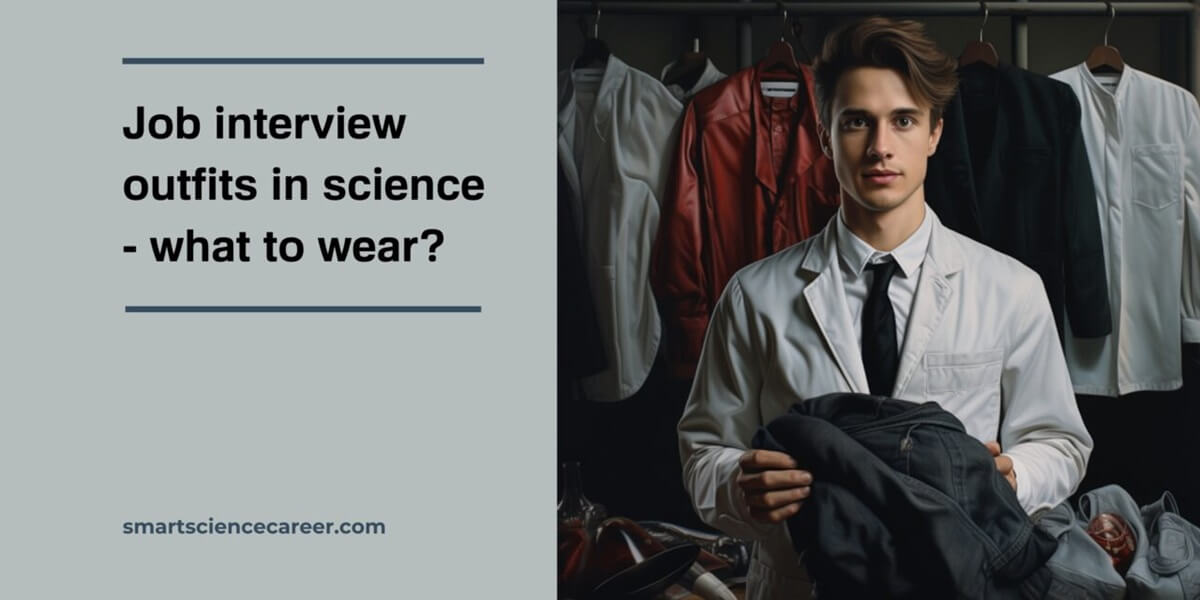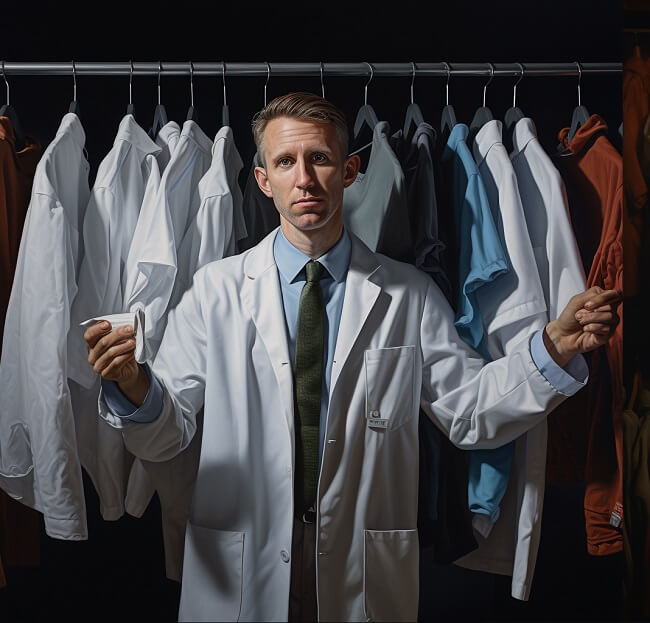Job interview outfits in science – what to wear?
Job interview outfits in science differ from those in other industries. In academia, basic scientists may underdress, while doctors and clinical researchers tend to overdress. Traditional attire may suit big pharma and established tech firms, while start-ups may favor smart-casual looks, and the social sector might value approachable attire.
How Important is the First Impression in Job Interviews?
First impressions play an integral role in an interview. The right outfit supports a great first impression.
From the moment an applicant enters an interview setting, their outfit plays a pivotal role in forming the initial perception in the interviewer’s mind.
Thus, you do not wear something. You strategically dress for a job interview.
There Are Immediate Judgments
An applicant’s attire is among the first things noticed. Within seconds, it can convey messages about their professionalism, confidence, and readiness for the interaction. In contrast, a careless outfit might suggest a lack of seriousness or attention to detail.
Standing Out – or Not?
With multiple candidates vying for a single position, the wrong outfit can ruin the first impression. You want the interviewers to recognize you for your performance, not for an inappropriate outfit choice.
In the selection round, you want them to remember you as “the candidate with the innovative approach for XYZ” and not as “the candidate with the weird shirt.”
However, if tattoos or piercings are a well-selected element of your culture or identity, you should carefully consider whether you hide them. You might get in trouble later if your conservative employer has a problem with such an outfit.
In contrast, I worked in Berlin and London, where many staff members had some tattoos or piercings. As far as I can judge, it did not influence the decisions of any selection committees.
Show Preparedness!
Thoughtful interview clothes showcases a candidate’s aesthetic sense and alludes to their meticulousness and earnestness about the position. However, a sloppy outfit might be interpreted as a sign that the candidate lacks preparation or isn’t genuinely interested in the role. Thus, you need to know how to dress for an interview!
Promote Constructive Interaction!
A favorable first impression can set a positive trajectory for the interview, prompting the interviewer to delve deeper into a candidate’s strengths and potential contributions.
Conversely, an unfavorable first impression might lead to a guarded interaction and more critical questions. Thus, strategically dress for your next interview.
What to Wear to an Interview in Different Sectors?
Different industries have varying dress codes, from business formal in corporate sectors to a casual dress code in some tech start-ups or basic academic research. It’s helpful to gauge the organization’s dress code to choose what to wear to a job interview.
A full suit or pant suit might be the go-to for formal sectors. Stick to neutral colors like navy, black, beige, or gray. Khaki pants and a button-down shirt could suffice in a casual workplace.
For more creative roles (for example, in advertising or marketing), bold colors and individual personal style can be expressed, but ensure it remains polished and professional.
Dress code differences between work environment, scientific meetings, and job interviews
Dress codes in the scientific field often vary substantially – based on context. Attire leans toward practicality and safety for daily work, especially in labs. For example, for safety reasons, tank tops, very long nails, or long open hairs are – no surprise – considered inappropriate in a lab setting.
Scientists might opt for casual or formal wear at scientific meetings, reflecting the event’s size, importance, and formality.
Meanwhile, for job interviews, attire tends to be more polished, aligning with the specific expectations of the hiring institution, be it academic, industry, or social sector-focused. The common lab interview questions should be about your qualifications and skill and not about your outfit. What to wear to a lab interview? Attire that allows you to wear a lab coat without problems.
Dress code differences between basic and clinical research
In my very personal experience, there is a big difference in the general dress code of scientists between fundamental and clinical research (my experience is limited to Europe and the US).
Scientific meetings on clinical research are often dominated by doctors in expensive suits, wearing expensive watches and ties.
In contrast, scientific meetings on basic sciences are often populated by scientists who care less about their outfits and tend to wear very casual outfits such as old T-shirts, jeans, and sneakers. Even the speakers do not necessarily wear a tie.
This is very useful to know when selecting your interview outfit for a job in basic or clinical research.
Dress code differences between traditional and modern universities
It is no big surprise: Traditional universities tend to have a more conservative dress code for scientists, while modern universities are more open to a variety of attire.
At traditional universities, job interviews are often seen as a formal event. This means that candidates are expected to dress in business professional attire, such as a suit and tie for men and a skirt suit or dress for women.
However, even at traditional universities, there is some flexibility in dress code depending on the specific department or position being interviewed for.
Modern universities, on the other hand, are generally more relaxed about dress codes. Candidates may be able to wear various types of clothing to a job interview, such as black pants and a blouse, a skirt and sweater, or even jeans and a nice top.
However, it is essential to note that even at modern universities, candidates should still dress professionally. This means avoiding too revealing or too casual interview outfits.
Can you overdress for an interview? Probably yes. However, I personally stick to the concept that it is always better to be overdressed than underdressed. If in doubt, dress more formally and more conservatively.
What does my future employer expect?
This is the one-million-dollar question! Getting an idea and a feeling about what your future boss and colleagues expect is very advisable to know how to dress for an interview.
How do you do that?
Very simple. Before your next interview, you should contact your future colleagues and ask questions about the project, the funding, and the working environment. This is a crucial aspect of interview preparation.
I often did this as the first thing – even before applying. I just called the employer and had a casual interview.
When contacting them before submitting your job application, you show genuine interest and a proactive attitude. In addition, it makes your job search more efficient. You may discover early that the job is not worth your application anyway because the supervisor is not nice, you are not really qualified, or the conditions are bad.
Read more here: The most intelligent strategy to get hired in science
In addition, you see what the staff members wear to work.
Does the technician or the postdoc wear a neat business uniform or a heavy metal T-shirt? If you have an informal discussion with your potential future boss *before* the official selection interview, you can already guess how conservative or casual their office dress code is. This gives you much better information than the company website and social media.
Ultimately, choosing an outfit that makes you feel confident and comfortable is the most important thing. When you feel good about yourself, you are likelier to project a positive image to your interviewers.
General Guidelines for Job Interview Outfits
You want to make the best impression on your potential employer and show you are serious about the position.
Here are some general tips for choosing a job interview attire that are relevant for most job interviews in most sectors:
- A suit might be an appropriate interview attire in clinical contexts with patient contacts or business contexts. In other contexts, you may not wear a suit to avoid overdressing. A nice pair of dress pants or a skirt and blouse is appropriate.
- Choose clothes that are in good condition: clean, pressed, and wrinkle-free. It is obvious – do not look like somebody who just came out of bed.
- For men, pairing a white shirt with a suit jacket is a safe bet in most contexts. Women can opt for pencil skirts or dress pants with a well-fitted blouse or button-down.
- Make sure your clothes fit you well and are pleasant to wear. Breathable fabrics are the best way to ensure you remain comfortable throughout the interview process.
- Your shoes should be very comfortable and confident. Beautiful dress shoes you wear for the first time during the interview are not a great idea.
- If you’re unsure of what to wear to an interview, it is always better to dress more formally.
What Does Business Casual and Smart Casual Mean?
Business casual and smart casual are dress codes that are less formal than traditional business attire. However, there is a subtle difference between the two.
Business casual is a dress code that is appropriate for the workplace in most office settings. It is typically more formal than smart casual, and it may involve wearing a blazer, dress pants, or a skirt. Business casual attire is also often more tailored and polished than smart casual interview clothes.
Smart casual is a dress code that is more relaxed than business casual. It is often appropriate for casual Fridays at work, as well as for social events and gatherings. Smart casual attire may include jeans, chinos, or a skirt with a blouse or sweater. However, it is important to note that even smart casual job interview clothes should still be professional and polished.
When aiming for business casual or smart casual interview looks, consider your outfit as a toned-down version of the traditional business attire.
Virtual Interviews: What to Wear to an Online Interview?
The pandemic has shifted many job obligations to remote work. As a result, online interviews are becoming very common. But just because it’s virtual doesn’t mean the clothes for job interviews are any less crucial.
Thus, how to dress for virtual interviews? Choose colors that are not distracting on camera, so stick to neutral colors and solid color pieces. It’s also a good idea to avoid clothing with intricate patterns, as these can appear distorted on screen.
During an in-person interview, the entire outfit matters, right down to the shoes. But the focus is mainly on the upper half for a video interview, such as on ZOOM, MS TEAMS, or Google Meet. Remember that while the interviewer may only see your upper half, you should still wear a complete outfit to maintain a professional posture and mindset – and for the possibility that you must stand up.
As good interview outfits for women, knee-length skirts or dress pants paired with a blouse might be your best bet. For men, a button-down shirt is often a safe bet, and while a full suit might not be necessary, it’s still a good rule of thumb to wear a blazer.
Many things can go wrong in an online interview, but your outfit should not be a part of it.
Job interview outfits for basic scientists in academia
Basic scientists in academia often underdress for interviews because they focus more on their research than their appearance. Additionally, many basic science departments have a more casual dress code for scientists than other departments, such as business or law schools. Still, you need to know how to dress for an interview.
Here are some specific outfit ideas:
For women:
- A pair of black or navy blue dress pants with a white dress shirt and a blazer or cardigan.
- A skirt or dress with a blouse or sweater.
For men:
- A pair of black or navy blue dress pants with a white or light blue button-down shirt and a blazer or sport coat.
- A khaki or navy blue polo shirt with dress pants or chinos.
Ultimately, the most important thing is to choose an outfit that makes you feel confident and comfortable. When you feel good about yourself, you are more likely to project a positive image to your interviewers.
Job interview attire for clinical scientists in academia
Clinical scientists in academia typically work in a more formal and professional atmosphere than basic scientists. This is because they often have to interact with patients and other healthcare professionals. As a result, clinical scientists may want to dress more formally for job interviews than basic scientists.
However, it is crucial to strike a balance between dressing formally and dressing in a way that is appropriate for the specific academic setting. For example, a candidate interviewing for a clinical scientist position at a research-intensive university may get away with wearing a more casual interview attire than a candidate interviewing for a clinical scientist position at a teaching hospital.
Here are some specific outfit ideas:
For women:
- A skirt suit or dress pants with a blouse.
- A sweater dress with black tights.
- A tailored blazer or cardigan over a dress or skirt.
For men:
- A suit and tie (to avoid overdressing, check before the dresscode in an informal conversation as described above).
- A sports coat and dress pants with a button-up shirt.
- A blazer and chinos with a button-down shirt.
How to Dress For a Job interview in Big Pharma and Tech Companies
Job interview outfits for scientists in big pharma and tech companies should be professional, polished, comfortable, and appropriate for the company culture.
The company’s dress code for scientists in Big Pharma tends to be more conservative than in tech companies. However, both industries are becoming more casual.
How do you know how to dress for a tech interview? To get a clearer picture how to dress for an interview, you can check the company’s website or social media accounts to understand the company’s culture better. But it is better to just contact the hiring manager or potential future colleagues before the selection interview to get a personal impression (see above).
The specific role and department should also guide your outfit choice; technical roles may allow for more relaxed job interview clothes like clean jeans and a nice shirt, whereas client-facing or executive positions might require leaning towards business casual or formal business attire.
Here are some specific outfit ideas:
For women:
- A skirt suit or dress pants with a blouse.
- A sweater dress with black tights.
- A tailored blazer or cardigan over a dress or skirt.
- For big pharma companies, you may want to choose a more conservative outfit, such as a skirt, suit, or dress pants with a blouse.
- For tech companies, you may be able to get away with a more casual job interview outfit, such as a pair of dress pants with a nice top or a skirt with a sweater.
For men:
- A suit and tie (to avoid overdressing, check before the job interview dress code in an informal conversation as described above).
- A blazer and chinos with a button-down shirt.
- For big pharma companies, you may want to choose to wear a more conservative outfit, such as a suit and tie.
- For tech companies, you may be able to get away with a more casual job interview outfit, such as a sports coat and dress pants with a button-down shirt.
What to wear to a job interview in a start-up company
A smart-casual look is the best option for job interviews at start-ups and modern tech firms. This dress code for scientists is more relaxed than formal business attire but still professional and polished.
Here are some specific outfit ideas:
For women:
- A pair of dress pants with a nice top or a skirt with a sweater.
- A tailored blazer or cardigan over a dress or skirt.
- A jumpsuit or romper.
For men:
- A pair of chinos or khakis with a button-down shirt and a blazer or sports coat.
- A polo shirt with dress pants or chinos.
- A button-down shirt with dark-wash jeans and a blazer.
You can also add a personal touch to your outfit, for example, by wearing a piece of jewelry. Just be sure to avoid anything too flashy or distracting.
Job interview outfits for scientists in the social sector
When applying in the social sector, such as NGOs or institutions in higher education policy, how to dress for an interview might be less easy to decide because these employers may have very distinct cultures. It may be advised to appear professional and approachable. You want to make a good impression on your potential employer, but you also want to show that you are relatable and down-to-earth.
In my (probably very limited) experience, the job interview dress code for scientists in old-money-funded private foundations is pretty conservative, while the dress code in crowd-funded NGOs is very casual.
Here are some specific outfit ideas:
For women:
- A pair of dress pants or a skirt with a blouse or sweater.
- A tailored blazer or cardigan over a dress or skirt.
- A jumpsuit or romper.
For men:
- A pair of chinos or khakis with a button-down shirt and a blazer or sport coat.
- A polo shirt with dress pants or chinos.
- A button-down shirt with jeans and a blazer.
Which outfit should you avoid in a job interview?
You want to look professional and polished but not flashy or distracting. Too much makeup or jewelry might be interpreted as unprofessional. Similarly, an eccentric outfit such as a fancy art shirt, animal prints, a band T-shirt, or a plastic lizard on your shoulder do not create a professional image.
In job interviews, it is advisable to avoid clothing that is too sexy or revealing. You do not want to be hired for your sexual attractiveness. In my personal opinion, this sets a sexual tone already at the beginning of your new job that might be a disadvantage later.
Can you wear jeans to an interview? Avoid too casual clothing because it might be perceived as disrespectful. This includes jeans, shorts, T-shirts, and tank tops. Baggy clothes can give off a too casual vibe.
You want to dress to show respect to the interviewer and the position you are applying for.
Frequently Asked Questions (FAQ)
What should I do if I don’t have any formal clothes for my job interview?
If you don’t have any formal clothes, don’t worry. You can still dress professionally without spending a lot of money. Try to find clothes that are clean, pressed, and well-fitting. You can also add accessories, such as a blazer, to make your outfit more formal.
What should I do with my tattoo or piercing in my job interview?
If you have a tattoo or piercing, you might cover it up for your job interview in a conservative work environment. However, if tattoos or piercings are essential to your identity, you should consider whether you hide them.
You may also consider whether you really want to work in a conservative or a more casual environment where tattoos or piercings are considered normal.
What should I do if I am not sure what to wear to my job interview?
If you’re not sure what to wear for your next job interview, platforms like Pinterest can be a handy resource. Simply search for interview outfits ideas or best interview outfits to find a plethora of suggestions tailored to every type of job interview.
Acknowledgments
I have used AI systems, including Grammarly, Google Bard, and ChatGPT, to enhance the English and comprehensiveness of this article. This post may contain affiliate links, meaning I get a small commission if you decide to purchase through my link. Thus, you support smartsciencecareer at no cost to you!
Recommended reading
The following articles may also interest you:
- The most intelligent strategy to get hired in science
- Online interview – the 5 biggest mistakes
- The 8 best tips to find your dream job in science
- Should I upload my cv on multiple science job websites?
- The most costly job interview mistake during your career in science!
- How to choose the best postdoc position?
- 9 reasons not to go abroad – and how to handle them!
- Will I find a job as a scientist?
- Free PhD programs versus fully funded PhD programs
- How To Write My Professor
- What is a Reader at a university?
- Why salary matters in science careers
- How to ask for a letter of recommendation?







